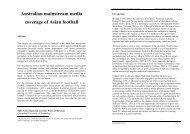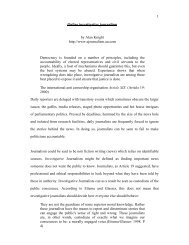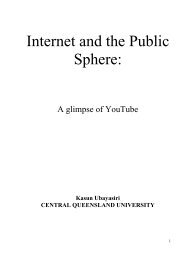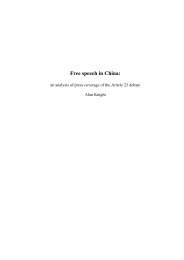Reading and drawing maps of the blogosphere. - eJournalist
Reading and drawing maps of the blogosphere. - eJournalist
Reading and drawing maps of the blogosphere. - eJournalist
Create successful ePaper yourself
Turn your PDF publications into a flip-book with our unique Google optimized e-Paper software.
Which way up? Tim Highfield<br />
physical reality, <strong>and</strong> this remains true for <strong>maps</strong> <strong>of</strong> fictional, digital, or virtual<br />
places.<br />
Of course, Stiebel <strong>and</strong> E<strong>the</strong>rington’s notion that “every map is in certain<br />
respects a fiction” is not restricted to fictional <strong>maps</strong> (2007, 41). Maps in<br />
everyday use distort geographical realities, from Harry Beck’s electrical<br />
circuit-inspired London Underground train map <strong>and</strong> its global replications, to<br />
<strong>the</strong> Mercator projection on world <strong>maps</strong>, for which <strong>the</strong> size <strong>of</strong> l<strong>and</strong>masses is a<br />
secondary concern to finding <strong>the</strong> shortest route for ships across oceans<br />
(Dorling <strong>and</strong> Fairbairn 1997, 44-53). In this sense, any concerns about<br />
representing non-physical spaces on a map may be diminished, for if <strong>the</strong>re is<br />
no ‘right’ portrayal <strong>of</strong> <strong>the</strong> internet, for example, <strong>the</strong>n any approach may be<br />
valid. Fur<strong>the</strong>rmore, Stiebel <strong>and</strong> E<strong>the</strong>rington, in studying fictional <strong>maps</strong>,<br />
describe <strong>the</strong> map accompanying Haggard’s (1885) King Solomon’s mines as<br />
“a powerful mental marker <strong>and</strong> spur to <strong>the</strong> imagination”, <strong>and</strong> this can be<br />
ascribed to o<strong>the</strong>r charts <strong>and</strong> <strong>maps</strong>, not least o<strong>the</strong>r representations <strong>of</strong><br />
‘unrepresentable realities’ (2007, 43).<br />
However, <strong>the</strong> actual process <strong>of</strong> mapping a space such as <strong>the</strong> <strong>blogosphere</strong> may<br />
not share many traits. Indeed, Packwood advises that avoiding cartographic<br />
conventions may be needed for internet-focussed <strong>maps</strong> (2004). Although<br />
Druaux’s map <strong>of</strong> <strong>the</strong> French-language <strong>blogosphere</strong> (2007, Figure 3) is clearly<br />
inspired by older cartographic traditions, adding in artistic details in <strong>the</strong> style<br />
<strong>of</strong> Swift’s African <strong>maps</strong> featuring “elephants for want <strong>of</strong> towns” (1733), <strong>and</strong><br />
o<strong>the</strong>r, comic <strong>maps</strong> such as that by Munroe (2007) also attempt to reconcile a<br />
geographical representation with digital communities; Packwood sees <strong>maps</strong><br />
<strong>of</strong> networks, based on links <strong>and</strong> traffic, as better ideals for charting <strong>the</strong><br />
<strong>blogosphere</strong> (2004). Fur<strong>the</strong>r, using online tools to map <strong>the</strong> <strong>blogosphere</strong> has<br />
implications for <strong>the</strong> map itself; Packwood claims that “any attempt to map<br />
<strong>the</strong> Internet using <strong>the</strong> Internet as a medium changes <strong>the</strong> thing it sets out to<br />
represent”, <strong>and</strong> <strong>the</strong> constant change online means that “<strong>maps</strong> <strong>of</strong> <strong>the</strong> Internet<br />
are out-<strong>of</strong>-date even as <strong>the</strong>y are inferred”. A <strong>blogosphere</strong> map may capture a<br />
moment in time, ra<strong>the</strong>r than providing a definitive, relevant overview <strong>of</strong> <strong>the</strong><br />
network, but to do so Packwood suggests focusing on <strong>the</strong> flows, <strong>of</strong> links,<br />
information, <strong>and</strong> site visitors, ra<strong>the</strong>r traditional cartographic methods. Several<br />
previous <strong>maps</strong> <strong>of</strong> <strong>the</strong> internet <strong>and</strong> parts <strong>of</strong> <strong>the</strong> <strong>blogosphere</strong> have attempted to<br />
use <strong>the</strong>se features as <strong>the</strong> basis for <strong>the</strong>ir depictions (for example, Kelly <strong>and</strong><br />
Etling 2008; Hurst 2006), <strong>and</strong> in <strong>the</strong> following sections <strong>the</strong>se approaches to<br />
Ejournalist.com.au 103<br />
Which way up? Tim Highfield<br />
mapping <strong>the</strong> internet <strong>and</strong> <strong>the</strong> <strong>blogosphere</strong> will be evaluated with a view to<br />
fur<strong>the</strong>r studies <strong>of</strong> online networks <strong>and</strong> communities.<br />
Figure 3: ‘highly subjective’ map <strong>of</strong> <strong>the</strong> Francophone <strong>blogosphere</strong> (Druaux<br />
2007)<br />
Mapping <strong>the</strong> internet<br />
Visualisations <strong>of</strong> <strong>the</strong> internet have been, for historical reasons, more widelydeveloped<br />
<strong>and</strong> documented than more specific <strong>maps</strong> such as those <strong>of</strong> <strong>the</strong><br />
<strong>blogosphere</strong> (for example, Dodge <strong>and</strong> Kitchin 2000; Abrams <strong>and</strong> Hall 2006).<br />
Dodge (2008) suggests three different modes <strong>of</strong> internet, <strong>and</strong> wider<br />
cyberspace, mapping: <strong>maps</strong> in cyberspace, <strong>maps</strong> <strong>of</strong> cyberspace, <strong>and</strong> <strong>maps</strong> for<br />
cyberspace (72). Of <strong>the</strong>se, <strong>the</strong> exercise <strong>of</strong> mapping <strong>the</strong> <strong>blogosphere</strong> fits into<br />
<strong>the</strong> second mode, being a visualisation <strong>of</strong> a part <strong>of</strong> cyberspace ra<strong>the</strong>r than a<br />
more ‘traditional’ format put online or a means for navigating <strong>the</strong><br />
<strong>blogosphere</strong>. For any map <strong>of</strong> cyberspace, Dodge <strong>of</strong>fers a definition <strong>of</strong> <strong>the</strong><br />
form as “any visual image that facilitates <strong>the</strong> spatial underst<strong>and</strong>ing <strong>of</strong> <strong>the</strong><br />
physical makeup <strong>and</strong> operation <strong>of</strong> cyberspace itself”, which can <strong>the</strong>n be<br />
adapted to <strong>the</strong> subset <strong>of</strong> cyberspace being mapped (77). These <strong>maps</strong> range in<br />
appearance from network <strong>maps</strong> to statistical diagrams <strong>and</strong> infrastructure<br />
Ejournalist.com.au 104








